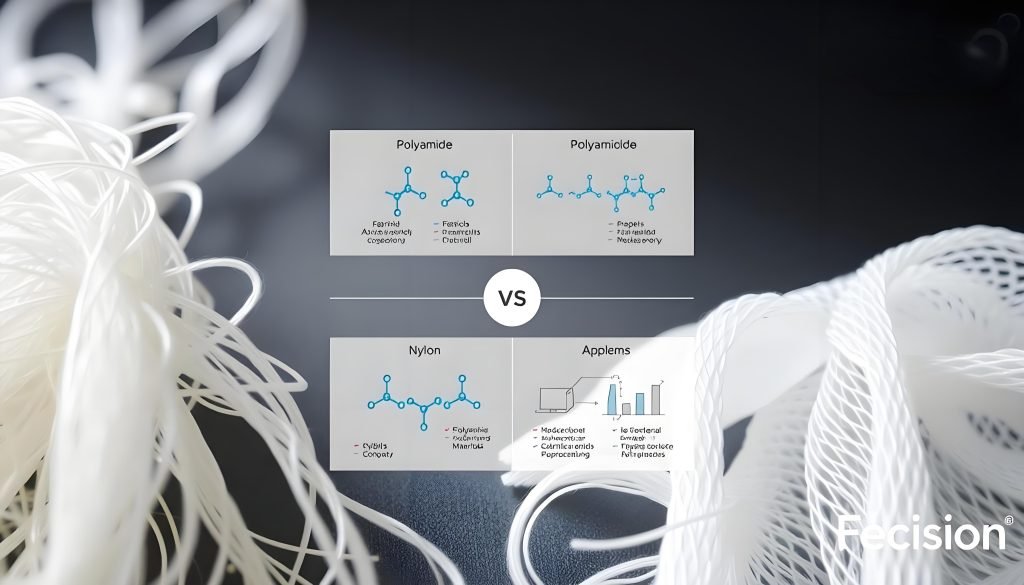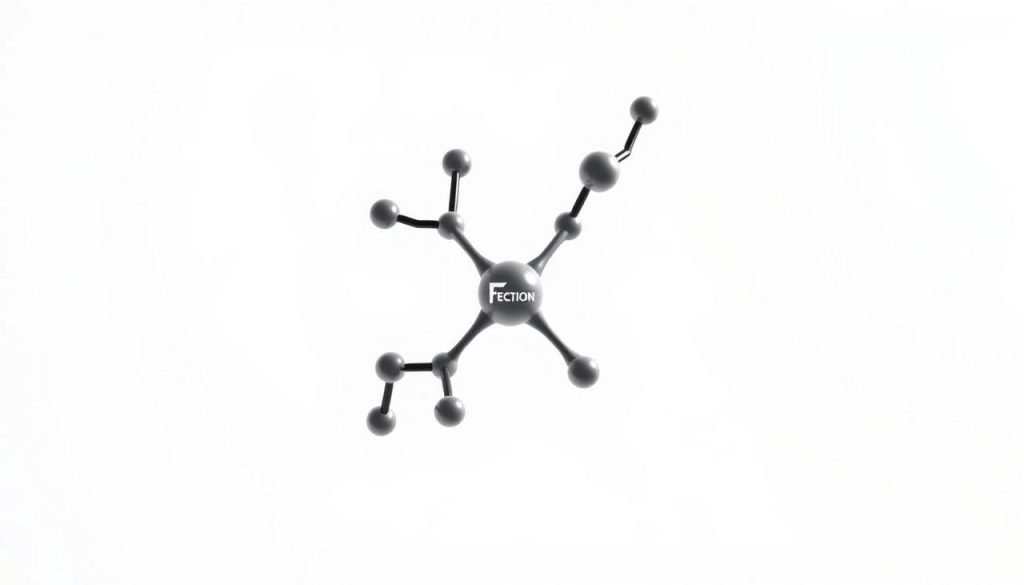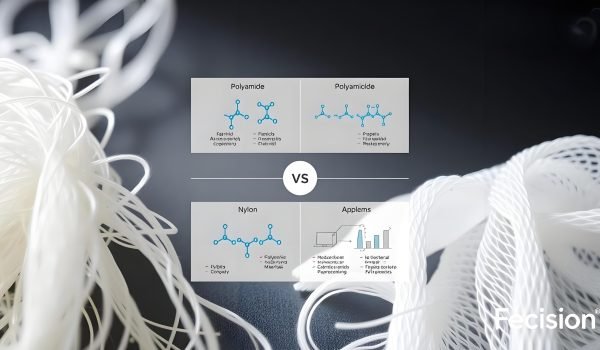Are polyamide and nylon interchangeable terms, or do they represent distinct materials with unique properties? This question often puzzles manufacturers and engineers who rely on these materials for their products.
Polyamide is a broad category of thermoplastic resins that include various types, with nylon being one of them. Nylon, in fact, is a specific type of polyamide known for its strength and versatility. Understanding the nuances between these materials is crucial for making informed decisions in manufacturing processes.
As we explore the differences between polyamide and nylon, we’ll examine their chemical compositions, properties, and applications. This will help clarify when to choose one material over the other for specific manufacturing needs.

Understanding Polyamides
The term ‘polyamide’ refers to a type of polymer characterized by the presence of amide bonds in its molecular structure. This defining characteristic gives polyamides their unique properties and versatility.
What Are Polyamides?
Polyamides are a broad class of polymers that can be either naturally occurring or synthetic. Natural polyamides include proteins found in wool and silk, while synthetic polyamides are man-made through chemical processes. The amide linkages in polyamides contribute to their exceptional strength, durability, and resistance to various environmental factors.
You’ll find that the amide groups create strong intermolecular bonds, giving polyamides their distinctive mechanical and thermal properties. Understanding the fundamental structure of polyamides helps appreciate why they’re chosen for applications ranging from textiles to high-performance engineering components.

Polyamides represent a versatile family of materials with diverse applications due to their unique properties. As you explore polyamides further, you’ll discover their significance in various industries.
Properties and Characteristics of Polyamides
Polyamides are valued for their broad spectrum of properties, which cater to diverse application needs. You will find that their characteristics make them suitable for a wide range of uses, from industrial applications to consumer products.
Mechanical Properties
Polyamides demonstrate exceptional mechanical properties, including high tensile strength and impact resistance. This makes them ideal for applications that require durability under stress. Their crystalline structure contributes to their rigidity, while their amorphous regions provide flexibility and impact absorption capabilities.
Thermal Properties
The thermal stability of polyamides allows them to maintain their structural integrity across a wide temperature range. Some varieties can withstand temperatures up to 200°C, making them suitable for applications exposed to high heat.
Chemical Resistance
Polyamides have excellent resistance to a variety of chemicals, oils, and solvents. However, they can be vulnerable to strong acids and bases. This resistance makes them valuable in environments where exposure to such substances is common.
Understanding these properties will help you determine whether polyamides meet your specific manufacturing requirements, especially for components that need to withstand mechanical stress, thermal fluctuations, or chemical exposure.
Applications of Polyamides
The applications of polyamides are diverse, ranging from consumer goods to industrial components. Polyamides are widely used materials that offer a broad spectrum of applications due to their excellent mechanical strength, wear resistance, and chemical resistance.
Industrial Applications
In industrial settings, polyamides are used in conveyor belts, cable ties, zip ties, and various mechanical parts where durability and resistance to wear are essential. These applications benefit from the material’s strength and flexibility.
Consumer Products
Consumer products commonly made from polyamides include clothing, sports equipment, furniture components, and household items. The use of polyamides in these products provides the necessary strength and flexibility.
Specialized Uses
You’ll discover specialized applications of polyamides in medical devices, automotive components, and aerospace parts. The unique combination of properties in polyamides provides significant advantages in these critical applications.
By understanding the various applications of polyamides, you can better appreciate their versatility and potential uses in different industries.
Nylon: A Specific Type of Polyamide
Nylon, a type of polyamide, has been a cornerstone in the development of modern synthetic fibers. As a specific type of aliphatic polyamide, nylon was first developed by DuPont in the 1930s, revolutionizing the materials industry as the world’s first truly synthetic fiber.

What is Nylon?
Nylon is a synthetic polyamide known for its high strength, elasticity, and resistance to abrasion and chemicals. It belongs to the aliphatic polyamide subcategory, characterized by linear chains of carbon atoms.
History and Development
Nylon was initially developed as a replacement for silk during World War II and quickly found applications in parachutes, ropes, and eventually consumer goods. Its development represented a significant breakthrough in polymer science, leading to numerous innovations in manufacturing and material design.
Common Types of Nylon
The most common types of nylon include Nylon 6 and Nylon 6,6, which differ in their molecular structure and properties. Understanding these differences is crucial for selecting the appropriate type for specific applications.
By understanding nylon’s place within the broader polyamide family, you can better appreciate why certain types are chosen for specific applications, from industrial uses to consumer products.
Composition and Structure of Nylon
Understanding nylon’s composition is crucial for appreciating its versatility in various applications. Nylon is an aliphatic polyamide, and its properties are largely determined by its chemical composition and molecular structure.
Chemical Composition
Nylon’s chemical composition features repeating units connected by amide bonds (-CONH-), formed through the reaction between amine groups and carboxylic acid groups. The precise arrangement of atoms in nylon’s molecular structure contributes to its crystallinity, which directly affects properties like tensile strength and chemical resistance.
Molecular Structure
The molecular structure of different nylon types varies. For instance, Nylon6 consists of a single type of repeating unit derived from caprolactam, while Nylon6,6 contains alternating units from two different monomers. Understanding the carbon chain length in different nylon varieties helps explain their varying properties.
Polymerization Process
Nylon is produced through different polymerization processes. Nylon6 is produced from the ring-opening polymerization of caprolactam, while Nylon6,6 is formed through the condensation polymerization of hexamethylenediamine and adipic acid. These processes result in distinct properties for each type of nylon.
Polyamide vs Nylon: Key Differences
To make informed decisions in material selection, it’s essential to grasp the differences between polyamide and nylon. While both are synthetic polymers, they vary significantly in their classification, structure, and applications.
Classification Differences
The fundamental difference lies in their classification. Polyamide is a broad category encompassing various polymer types, including nylon, which is a specific type of aliphatic polyamide. Nylon represents just one subcategory within the polyamide family, which also includes aramids and other specialized varieties.
Structural Variations
General polyamides and nylon exhibit structural variations that affect their physical and chemical properties. These differences are crucial in determining their suitability for various applications.
Performance Characteristics
The performance characteristics of different polyamides versus specific nylon types vary in terms of tensile strength, melting point, moisture absorption, and chemical resistance. Understanding these differences is vital for selecting the right material.
Application Distinctions
The distinctions in their characteristics lead to different application areas. Nylon is commonly used in fibers and plastics, while other types of polyamides are used in specialized applications requiring unique properties.
Manufacturing Techniques for Polyamide and Nylon
Manufacturing techniques play a vital role in determining the characteristics of polyamide and nylon materials. Understanding these techniques is essential for selecting the right production method for your specific application.
Polymerization Methods
Polyamides are synthesized using two primary methods: condensation polymerization and ring-opening polymerization. Condensation polymerization is commonly used for producing both aliphatic and aromatic polyamides, such as Nylon 6,6. Ring-opening polymerization, on the other hand, is primarily used for aliphatic polyamides like Nylon 6. These
polymerization methods significantly affect the final properties of the material.
Processing Techniques
Various processing techniques are employed to manufacture polyamide and nylon parts. Injection molding is widely used for producing parts that require high heat resistance and mechanical performance. Extrusion and 3D printing are also utilized, depending on the production requirements and part geometries.
Quality Control Measures
Quality control is crucial throughout the manufacturing process to ensure consistent material properties and performance reliability. By implementing stringent quality control measures, manufacturers can guarantee the dimensional accuracy and performance of polyamide and nylon parts, meeting specific application requirements.
Sustainability and Recyclability
As manufacturers increasingly prioritize reducing environmental impact, the sustainability of polyamide and nylon materials becomes a critical consideration. You will learn about the challenges associated with the production of these materials and the innovative recycling technologies that are helping to mitigate their environmental footprint.
Environmental Impact
The production of polyamide and nylon is derived from non-renewable petroleum resources and involves energy-intensive manufacturing processes, contributing to their significant environmental impact. Understanding the environmental challenges associated with these materials is crucial for developing more sustainable material management strategies.
Recycling Processes
Nylon recycling methods include physical and chemical recycling. Physical recycling involves reprocessing and granulating waste nylon for further use, while chemical recycling converts it into oil, gas, carbon, monomers, or new plastic with qualities equivalent to petroleum-based plastics.
| Recycling Method | Description | Outcome |
| Physical Recycling | Reprocessing and granulating waste nylon | Reusable nylon material |
| Chemical Recycling | Converting nylon through chemical processes | Oil, gas, carbon, monomers, or new plastic |
Biodegradability Considerations
While polyamide and nylon are not biodegradable in the traditional sense, innovations in bio-based polyamides are helping to reduce their environmental impact. Understanding the limitations of current recycling technologies is crucial for developing more sustainable practices.
You can see how the recycling of polyamide and nylon is vital for reducing their environmental footprint. By adopting recycling methods and developing bio-based alternatives, the impact of these materials can be significantly mitigated.
Conclusion
As we’ve seen, polyamide and nylon share a complex relationship, with each material bringing its own strengths to the table. Polyamide encompasses a broad range of polymers, including nylon, one of its most widely used subsets.
You now understand that nylon is a specific type of aliphatic polyamide, and both materials offer exceptional versatility across numerous applications. Their high tensile strength, impact resistance, and chemical resistance make them excellent choices for parts that need to withstand challenging environments.
When selecting between polyamide and nylon for your manufacturing needs, consider factors such as required mechanical properties, operating temperature, and cost constraints. Both materials continue to evolve through innovations in manufacturing techniques and sustainability initiatives, ensuring they remain valuable engineering materials for a wide range of applications.




